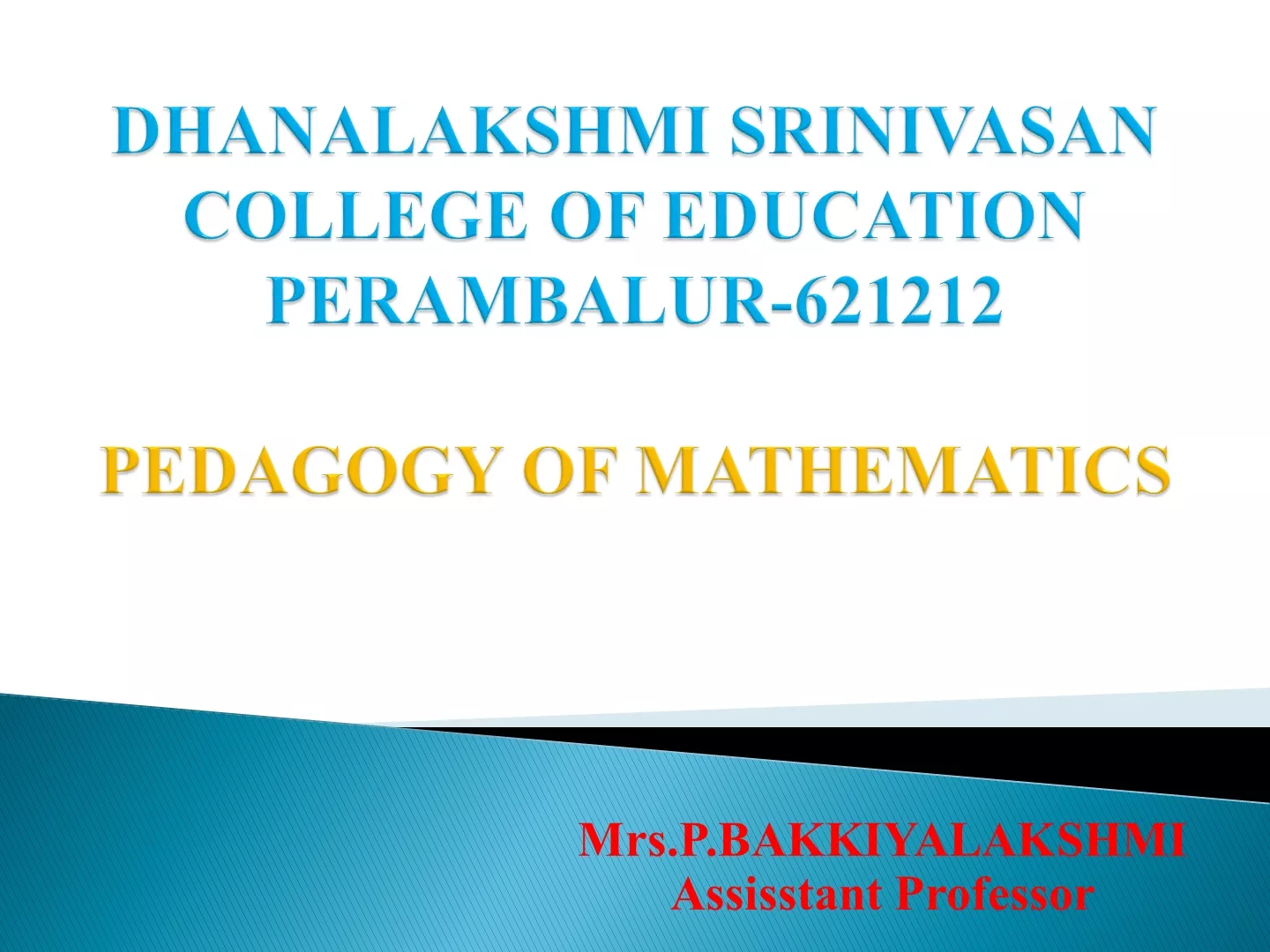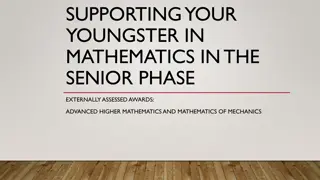Unlocking the Power of Oracy in Mathematics Education
Exploring the impact of oracy in the mathematics classroom for Black African, Caribbean, and mixed-race students. Analyses of data highlight disparities in performance and progression, emphasizing the need for interventions to address systemic inequalities. The complex interplay of historical, familial, and educational factors further complicates the issue, calling for a comprehensive approach to ensure equitable outcomes in mathematics education.
Download Presentation

Please find below an Image/Link to download the presentation.
The content on the website is provided AS IS for your information and personal use only. It may not be sold, licensed, or shared on other websites without obtaining consent from the author.If you encounter any issues during the download, it is possible that the publisher has removed the file from their server.
You are allowed to download the files provided on this website for personal or commercial use, subject to the condition that they are used lawfully. All files are the property of their respective owners.
The content on the website is provided AS IS for your information and personal use only. It may not be sold, licensed, or shared on other websites without obtaining consent from the author.
E N D
Presentation Transcript
The Power of Oracy in the Mathematics Classroom Building confidence and improving outcomes for our Black African, Caribbean and Mixed Race students
2018 Cohort Data Crunching 70 About 5 years ago I did a research action project on outcomes in Mathematics at KS4. 60 Analysis of our data showed Black African, Black Caribbean and particularly Mixed Race Black students were doing poorly in comparison to their peers. Especially boys. 50 40 Frequency Two years ago SMCS identified a significant problem with progression among Black African, Black Caribbean and Pakistani boys. It became a whole school focus. 30 20 In Maths, the disparity among Black students is more pronounced, with almost no-one pursuing the subject at Level 3. 10 0 Positive Negative Subject Progress Index BAFR BCRB Other
The Normal Distribution and GCSE Data for Mathematics shows a worrying pattern, with a marked skew towards lower grades among both Black African and Caribbean students. The normal distribution is a natural phenomenon that occurs when you gather huge volumes of data namely raw scores at GCSE with small numbers of people at either end and the vast majority sitting in the middle. Distributions of different ethnic cohorts within the main curve should in theory reflect the general trend. But they don t. 40 SMCS Mathematics GCSE Scores 2018 35 30 25 Frequency 20 15 10 5 U 1 2 3 4 5 6 7 8 9 0 3 and under 4 5 6 7+ GCSE Grades
Changing the Foundations The problem starts much earlier than Key Stage 4, with patterns embedded by Year 9. Comparison of Current Year 9 Key Stage 3 Grades (to date) 120 Year 7 Year 8 Year 9 100 Frequencies 80 60 40 20 0 WGD WA WT2 WT1 WGD WA WT2 WT1 WGD WA WT2 WT1 WGD WA WT2 WT1 WGD WA WT2 WT1 Year 9 (AP1) WGD WA WT2 WT1 Year 7 Year 8 BAFR and BCRB students The implication of the final bar chart is that BAFR and BCRB students will be over represented in Foundation sets. This will preclude access to Level 3 courses and the opportunities afforded by studying Mathematics at a higher level. Students with Other Ethnicities
A Complex Picture Different histories and family experiences impact on attitudes towards education. Author of the recent controversial report on inequality, Professor Steve Strand, referred to the immigrant paradigm (KAO and Thompson, 2003). (It) suggests that recent immigrants devote themselves more to education than the native population because they lack financial capital and see education as a way out of poverty. First or second generation Third or fourth generation However it is worth considering that families who descend from the Windrush generation experienced the racial discrimination that led to the race riots of the 1980s. These are the parents of our black and mixed race Caribbean students.
A National Problem The groups with the lowest achievement at 16 years old are White British, and Black Caribbean and Mixed White and Black Caribbean students from low socio-economic status (SES) backgrounds, who have mean scores well below the average for all students. There is no single solution There is no easy solution But it is one where we can all make a difference
By Considering Our Environment In an article on young people from mixed race backgrounds, Dinah Morley states that The experience of school has a huge impact on their personal development Confidence building is important and it helps to move through an environment that makes you feel better, for example, where there are pictures of mixed race people. (The Voice) It is good to see posters from Black History Month program still present around school. Our department displays celebrate Mathematical heroes from all sections of society. Thereby proving you don t have to be ancient or Greek to be good at Maths. Where possible we should extend these to our own students participating in Maths.
and we can do more We can highlight the origin of key concepts in our teaching, especially ones that have not originated in Europe or North America. Did you know the place holder zero was invented in India? Most importantly, we need to make sure BAFR and BCRB students have an opportunity to contribute and answer questions in every lesson. Hear their voices participating in debate in every lesson
Oracy Working Group Led by Gemma McGuigan Last term we focused on presentation Rachel Bull fed back on a strategy she used in Science with Year 7s Students created a poster and presented it to their peers The students assessed each others presentations They used a pro-forma to formalise their feedback This is the idea that I pinched And I listened to the emphasis placed on Student Voice in the recent deep dive program
Translating into Mathematics Marking & Feedback Identified upcoming topics Students were taught the basics Outcomes were measured using the online skills test facility on Kerboodle Scaffolded worksheet of four questions Student Voice response was garnered through an MS Teams survey Students prepared two answers as homework Students presented to their partner Partner fed back using the pro-forma Ryan Crockford was particularly hot on how I could improve
A Mixed Picture Online Skills Test % Score Distributions Year 7 Year 8 Year 9 Year 8 has a disappointing negative skew for all reflecting both the impact of the pandemic during transition from KS2 and disruption to learning during Autumn term. Contrast with Years 7 and 9, where there is a more normally distributed pattern, with few students doing poorly.
The presentation exercise helped me to be more confident in Mathematics Sharing my work with my partner helped me understand how I had done things and maybe if I could have improved something if I had missed it out. (Year 8) student Voice BAFR/BCRB Other Being able to explain my topic to my peer helped me to understand the topic Not true at all Slightly true Somewhat true Extremely true Answers It helped me understand percentages a bit better when explaining it rather than just writing it. (Year 8) doing presentations helped me much more as I can explain in my own way how to solve the question and would love to do more... (Year 8) Not true at all Slightly true Somewhat true Extremely true Answers
I liked doing this because it helped me understand the topic by going through the steps and explaining it to someone else. (Year 8) It helped to make sure [that I] know what I am doing right and wrong and to understand the topic enough to explain it to my partner. (Year 9) Very helpful Thank you! (Year 9) Next Step: Exploratory Talk Teach
Changing My Perspective Compelling explanation of white privilege that makes you think Development of the black consciousness movement Liberal self-satisfaction exploded by a trip to the supermarket David Monteith























